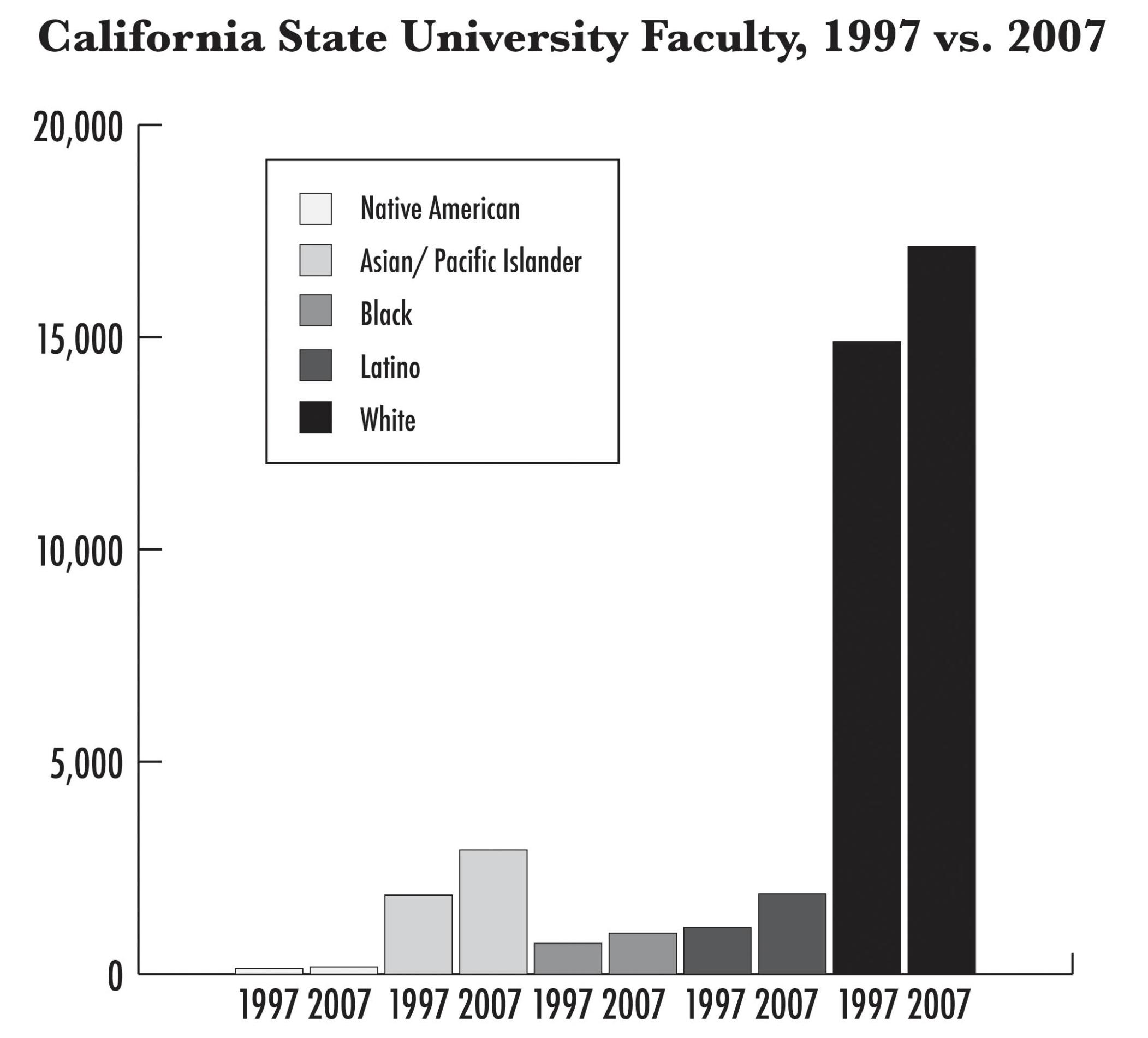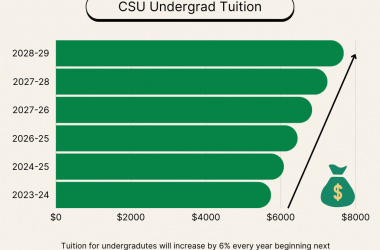[The first of this two-part series will focus on the low rate of faculty diversity in the California State University system. Tomorrow’s Part Two will spotlight some of the challenges and implications of not having more ethnically diverse faculty representation at Cal State Long Beach.]
The messages delivered at a Cal State Long Beach symposium on faculty ethnic diversity concluded that there is not enough being done in the way of minority faculty outreach, growth or retention by the California State University system as a whole.
Friday’s conference in the Karl Anatol Center, sponsored by the College of Liberal Arts, focused on debunking some of the traditional myths that surround recruiting, hiring and retaining faculty of color in higher education.
Daryl Smith, a professor of education and psychology at Claremont Graduate University in Claremont, Calif., was a keynote speaker at the event. She presented findings on collaborative research conducted with José Moreno, a CSULB Chicano-Latino studies professor, and other educational specialists.
Smith said that, although some strides have been made in increasing the numbers of minority faculty within the CSU system, the journey is slower and more cumbersome than it should be.
Among the myths Smith targeted was that there isn’t enough available minority teaching talent to recruit to public universities. To overcome the misconception, she said searches by department hiring committees could reach out to more diverse candidate pools, including the option of hiring community college professors to fill openings.
“Minorities are having trouble getting academe jobs,” Smith said, imploring that search committees not only identify potential talent, but fine-tune how they scrutinize candidates. “Stay away from elitism.”
Too often, Smith explained, hiring committees place more attention on pedigrees such as where the candidate earned their doctorates than what they actually accomplish in their local teaching communities.
Another myth Smith highlighted is that minorities are leaving academic jobs for government or industrial positions.
“These myths become self-fulfilling prophecy. We have lots of reasons for the failure of faculty diversity,” Smith said. “We do not accept reasons when it comes to certain demands.”
Data for instructional faculty over the 10-year period between 1997 and 2007 provided by the third presenter, Linda Turner-Bynoe, a California Faculty Association representative for the CSU Council for Affirmative Action, shows that growth in most racial/ethnic categories was either slow or non-existent.
Of the 18,887 total CSU faculty employed in 1997, blacks comprised 4 percent, representing the same percentage of 2007’s 24,159 faculty members. In real numbers, blacks went from 721 in 1997 to 963 in 2007.
The black student population grew from 22,005 to 25,956 during that same span — a system-wide dip of 1 percent from 8 to 7 percent.
Latino faculty grew two percentage points, from 6 percent in 1997 to 8 percent in 2007, representing growth from 1,096 to 1,887 respectively. Comparatively, the Latino student population grew by 6 percent between 1997 and 2007, from 22 to 28 percent, or from 65,079 in 1997 to 99,499 in 2007.
“I knew what the data was. It’s discouraging, but I hope it gets better,” said Linda Vazquez, a CSULB senior human development and Chicano-Latino studies major. “It has been changing, even though it’s been real slow.”
The ethnic group with the most growth was Asian/Pacific Islander faculty, climbing three percentage points from 10 to 13 percent. There were 1,858 Asian/Pacific Islander faculty in 1997 and 2,923 in 2007. Asian/Pacific Islander student enrollment went from 61,504 to 75,405 during that period with no shift in overall percentages.
American Indian faculty remained at less than 1 percent of the total, with 133 in 1997 and 169 in 2007. Although the American Indian student population also remained at less than 1 percent, actual enrollment dropped from 3,583 to 2,977 during that period.
While white faculty increased from 14,897 to 17,139 during the referenced years, the percentages dropped to representing 74 percent of faculty in 2007 versus 80 percent in 1997.
“[Faculty diversity is] one of the quintessential challenges we’re facing,” said the CLA Dean Gerry Riposa. “Democracy is strained when we don’t have respect for diversity.”
Priscilla Luviano, a senior Chicano-Latino studies major, said in order to solve this issue at the CSU level, “We need to bring this to the attention of people in power so they can address this issue.”
Luviano said it’s important for students to have faculty with similar ethnic and cultural backgrounds to serve as teachers, mentors and advisers.
Part of the problem of increasing and maintaining faculty diversity, Smith explained, is the “turnover quotient.” Between 2000 and 2004, “new hires were more diverse,” Smith said. “But overall diversity after five years is not as diverse. About 50 percent of faculty was replaced in five years. What’s the problem? Turnover.”
Some of the potential difficulties in keeping faculty were presented during a CSULB Latino faculty focus group last year. A pilot project preliminary report, while incomplete, indicated some “external factors” could include the “high cost of living, concerns of raising children in an urban setting and crime” as reasons faculty might leave.
Other suggestions in the evolving study addressed possible internal challenges that include “low pay, lack of support for obtaining housing, tension between professors in particular departments [and] lack of ethnic diversity among professors.”
Approximately 150 students, faculty, administrators and community members attended the morning presentation organized by Chicano-Latino studies professor Victor Rodriguez. A smaller lunchtime discussion between the presenters and CSULB executive administrators took place in the Chartroom following the conference.
Before the luncheon, CSULB President F. King Alexander offered a more optimistic outlook.
“We need to learn different recruiting techniques. Pools are much more robust during these times,” Alexander said. “Often [diverse faculty hirees] are only being recruited by 6 to 7 percent of universities during a bad economy, which can be an advantage for us.”
The consensus of the presenters was to stress ownership on all parts, including administrators, faculty and students. Smith said it affects the community’s perception of institutional credibility.
“[Without greater diversity] an institution can be rightly accused of hypocrisy,” Smith said.
Moreno said, “Students need to understand their power. They can be empowered that they are the client at the table. I encourage students to put themselves into a diversity state of mind.”
This article was updated at 12:26 p.m. on Monday, April 27, 2009.





Whether you look at the raw numbers or the percentages, my point is this: from 1997 through 2007, the number of minority faculty grew at a faster rate than the number of white faculty. Any careful observer would get this from the article. If we assume that more diversity is required (a point that I don’t necessarily accept at face value), then the article should more blatantly acknowledge this improvement (although this improvement was not true of all minority races).
I understand that the authors did not have space to write a whole book, but the supplemental information would be nice to know. I’ll concede that knowing what other university systems’ racial makeup is like may not be that useful, because CSULB and the CSU should be setting the example, not following others. However, knowing what the applicant pool is like would definitely be important. I would guess that the graduating PhD students are more diverse now than in years past, meaning that the applicant pool for new faculty will be more diverse. I am curious to see the makeup of CSULB’s recent hires. I’ll bet money that it is more diverse than the current makeup. The reason it is so slow is that so many of the professors hired a long time ago are white and have earned tenure. If we want a radical change in faculty diversity, how would we do it? Should we eliminate some white faculty members so that the percentage of minorities increases? Obviously not since that would be racist for firing white people because they are white. Should we only hire minorities for a couple of years until we are happy with the balance? Probably not, since we are again excluding white people. Perhaps we should allow the system time to adjust to the newer, more diverse applicant pool as it has been doing for over a decade.
Whether you look at the raw numbers or the percentages, my point is this: from 1997 through 2007, the number of minority faculty grew at a faster rate than the number of white faculty. Any careful observer would get this from the article. If we assume that more diversity is required (a point that I don’t necessarily accept at face value), then the article should more blatantly acknowledge this improvement (although this improvement was not true of all minority races).
I understand that the authors did not have space to write a whole book, but the supplemental information would be nice to know. I’ll concede that knowing what other university systems’ racial makeup is like may not be that useful, because CSULB and the CSU should be setting the example, not following others. However, knowing what the applicant pool is like would definitely be important. I would guess that the graduating PhD students are more diverse now than in years past, meaning that the applicant pool for new faculty will be more diverse. I am curious to see the makeup of CSULB’s recent hires. I’ll bet money that it is more diverse than the current makeup. The reason it is so slow is that so many of the professors hired a long time ago are white and have earned tenure. If we want a radical change in faculty diversity, how would we do it? Should we eliminate some white faculty members so that the percentage of minorities increases? Obviously not since that would be racist for firing white people because they are white. Should we only hire minorities for a couple of years until we are happy with the balance? Probably not, since we are again excluding white people. Perhaps we should allow the system time to adjust to the newer, more diverse applicant pool as it has been doing for over a decade.
Hey Chris L, look at the graphs. That tells a story in and of itself.
Chris L, you need to factor that percentages don’t give a comprehensive picture without actual numbers, which the article includes. Much of the percentage loss is due to attrition and the CSU doesn’t replace them with the line with which the ethnicity was lost, leaving a lopsided and skewed overall accounting. The article gives a pretty comprehensive outlook if you consider the small space the reporters had to deliver a lot of information. I’ve seen the data and it’s way too much for a small representation of the bigger picture. They condensed it fairly well.
It looks like faculty diversity has actually been improving over the last 10 years. According to the article, 80% of the faculty were white, compared to just 74% now. That means that minority faculty has increased from 20% to 26%.
And the article is not very thorough. It does not address the racial makeup of other schools’ faculty . It also does not address the racial makeup of graduating PhD students. If 75% of graduating doctorates are white, then there is no problem in the way we recruit.
Conseritive voices are the true minority at the CSULB professorial level, hirering people of color with the same leftist beleifs is not true diversity
It is what it is. Who really cares? Tell us some chit we don’t already know. If you don’t own it, you can’t change the fence.
Everybody, including white students and faculty, will benefit greatly in a global environment when our public education systems embrace, rather than reject, diversity at all levels. That’s true participation in a democratic society.
Can anybody spell H-E-G-E-M-O-N-Y? Nothing points to the urgent need to faculty diversify in our universities better than this article. These reporters were fairly thorough and should be lauded for their work on a subject many others are afraid to touch. Minority faculty are staying away in droves because the bureaucracy has no incentive to join. There are so many qualified and dedicated educators out there, but outreach is intended to protect the old guard. Thank you for publishing these concepts.
You should investigate how many minorities are in administration throughout the system AND at Long Beach State. The numbers are probably a lot lower for people of color in decision making positions throughout this bureaucracy. Great job in pointing out that this is a very serious problem. It literally seems like the system is trying to alienate students from faculty with similar cultural backgrounds. Business as usual.
It almost looks like American Indians and African Americans are dying breeds in the CSU.
Shouldn’t the tall bars in the graph be white? This is a sick way to run a ‘public’ university system. I hope when all of these lazy, boring white professors retire, the CSU sees the errors of its ways. Prolly not though.